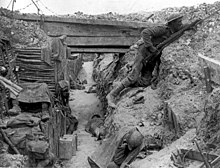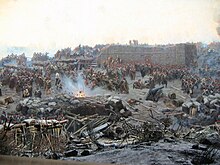Trench warfare

As grave war refers to a type of position War , at the two opposite front connectors each composed of a system of rifle and trenches exist. The reasons for this front consolidation were opposing forces meeting in opposite directions, almost equally strong enemy troops, which had both technically advanced artillery with effective grenades and high gun range, as well as the then newly emerged machine guns . However, the mobility of the new heavy weapons in the mostly impassable terrain remained low, especially since the draft animals required for the opening credits were just as exposed to the increased weapon effect as the people.
Major trench warfare occurred for the first time in the Crimean War in 1854 , when the Russian engineer officer Franz Totleben used this defense concept .
In the period that followed, the American Civil War (1861–1865) and the Russo-Japanese War (1904–1905) also fought in trenches.
This type of warfare reached its bloody climax in the trench warfare of the First World War . Between February and December 1916, over 700,000 soldiers were killed or injured in the Battle of Verdun alone . The fighting could not change the course of the front significantly. At the Battle of Gallipoli , too, the fronts froze and trench warfare after the amphibious landing. In order to avoid the associated high losses, the tactic of mobile combat with armored vehicles was developed in Europe and the USA in the interwar period and was used in the great tank battles at the beginning of the Second World War .
In the Second World War, the bulk of the infantry was not motorized . The battles often took place around and with field positions. The end of this kind of combat operations came through the rapid armored advances in mobile warfare which had the objective to penetrate through gaps and weaknesses in the defense deep in the enemy's battlespace and encircle there units of the enemy infantry and cut off from supplies and of the remaining troops.
Even in the Iran-Iraq war (1980–1988) there were heavy losses in trench warfare, as the difficult fighting terrain and the low level of mechanization opposed a war of movement.
The term trench warfare is often used metaphorically to denote conversational situations in which disputing parties make the same reproaches to each other over and over again, without dealing with what is held up to them and without going into it, which does not make the conversation progress and does not lead to an agreement.
background
Cordons (border fortifications) were built in antiquity, however, due to the limited size of the armies and the limited range of the weapons , it was usually not possible to defend more than one section. The great fortifications of antiquity such as Hadrian's Wall (England), the Limes (Germany) or the Great Wall of China are more of the exceptions to the rule and primarily served to make crossing the border more difficult and to control, but not completely prevent it.
Field fortifications were seldom used in open field battles, as their installation takes considerable time. Field battles were comparatively short; the losing party often withdrew to a fortress , which was then besieged . Nevertheless, the Arab Muslims already use Medina's trenches ( Battle of the Trench of 627) to defend themselves against the cavalry .
Although both fortifications and armament underwent massive development in the second half of the second millennium, the introduction of firearms initially did not fundamentally change the fact that fortifications require a large number of troops to defend them. Smaller units could not generate the firepower necessary to stop an attack.
The introduction of artillery during the times of the Ottoman Empire and the battles that took place during the siege of Vienna had a massive impact on the construction of the fortress and the siege. The attacking infantry were forced to approach the fortress in Apendet (approach trenches).
The introduction of large conscript armies at the time of the French Revolution and the Napoleonic Wars was important for the emergence of trench warfare and trench warfare . Large armies made it more difficult to outmaneuver the enemy and attack the flanks. With the introduction of machine guns like the Gatling in particular, it became more and more necessary for the infantry to protect themselves in field positions from attacks and fire using artillery that became more and more effective.
For the trench warfare, the use of ground obstacles such as S-wire , Spanish riders and crow's feet, as well as barbed wire today, became more and more important in addition to field construction .
Wars with trench warfare
Crimean War
Before the siege of Sevastopol , the Russians had makeshift trench systems built to defend the city. Rifles with rifled barrels (e.g. Enfield Rifled Musket ) were used for the first time , with which one could hit at a great distance. Although known for a long time, the effectiveness of hand grenades was recognized in trench warfare .
Civil War
The Civil War was initially fought using tactics from the Napoleonic era, but towards the end the war became a preview of the First World War. So winning field fortifications increasingly important. These included the Spanish horsemen made of pointed wooden stakes , but also the first landmines . The Battle of Cold Harbor is considered to be the first open field battle, i.e. not a siege that froze into a trench warfare with trench systems.
The Atlanta Campaign and the Siege of Petersburg towards the end of the Civil War stood with their trenches in marked contrast to early battles such as the First Battle of the Bull Run . Attacks like " Pickett's Charge " at the Battle of Gettysburg clearly showed how pointless an attack on a concentrated line of defense had become.
Russo-Japanese War
In the Russo-Japanese War (1904–1905) barbed wire and machine guns were used for the first time during the siege of Port Arthur . The infantry was also equipped with breech-loaders throughout , which enabled a small force to develop greater firepower. A small group of defenders could therefore repel attackers much more easily with adequate cover.
First World War
- Main article : Trench warfare in World War I
When the war broke out, the troops realized that even the smallest cover enabled the defender to repel a frontal attacking enemy. Frontal attacks resulted in dramatic losses; therefore, flank attacks were seen as the only way to win. After the Battle of the Marne, this led to a series of encircling maneuvers that only ended when both armies reached the coast. The rift system on the western front stretched from the North Sea to Switzerland .
After the First World War, trench warfare took place very rarely.
Second World War
The Second World War was shaped by the war of movement of the mechanized troops and the aerial warfare both on the operational and tactical level, at the beginning mostly against an opponent who in turn relied on expanded fortifications and field positions such as the Maginot Line in France or the Metaxas Line in Greece. These were usually breached quickly.
Nevertheless, even the Wehrmacht secured and defended large sections of the front in the Russian campaign for long periods of time using infantry in expanded field positions and bunker lines, and tried to compensate for the lack of mobility through the Atlantic Wall . Each of these defense systems could usually be breached by the attacker in a few hours and the other subsequent parts made obsolete.
This was also evident in the Indochina War such as the Battle of Điện Biên Phủ and the Korean War .
Iran-Iraq war
The most famous example of trench warfare after World War I was the Iran-Iraq War . In this war, both sides had a large infantry army, but very little armored vehicles, airplanes or the necessary training. The result was a battle with trenches and the use of chemical weapons, comparable to the First World War.
Eritrea-Ethiopia War
Another example can be the war between Ethiopia and Eritrea , in which also primarily infantry units clashed.
Countermeasures
After the attrition battles of World War I, the military strategists looked for new tactics. This is how the Blitzkrieg was developed, a combined, coordinated deployment of various mobile armed forces.
The technical obsolescence of trench warfare was demonstrated by the USA in the Second Gulf War . Iraq tried to defend itself against the USA with a static rift line, but it failed. The US was able to break through most of the Iraqi lines, not least through a successful combination of air and ground strikes. The futility of the trenches was also illustrated by the use of armored bulldozers, which filled in the trenches and thus buried the Iraqi soldiers alive.
Figurative meaning
Due to the decisive experiences of the First World War, the terms “trench warfare” and “trench warfare” have become metaphors in German . If the fronts harden in disputes in families, companies or other social groups, individual parties are irreconcilable and the same arguments or mostly only insults are exchanged, and in which none of the participants is willing to give in even the slightest, this becomes in the figurative sense often referred to as trench warfare. A particularly frequent use of the word took place in the 1990s.
See also
literature
- Nicholas Murray: The Rocky Road to the Great War: The Evolution of Trench Warfare to 1914 . Potomac Books, 2013, ISBN 978-1-59797-553-7 .
- Anthony Saunders: Trench Warfare 1850-1950 . Pen and Sword Books, 2010, ISBN 978-1-84884-190-1 .
Web links
- International historical films on the topic of trench warfare in World War I on europeanfilmgateway.eu
- German Armed Forces - Jäger shock troop in trench warfare ( YouTube video, July 24, 2017)
References
- ↑ http://news.bbc.co.uk/1/hi/programmes/from_our_own_correspondent/756845.stm
- ↑ Patrick J. Sloyan: Bodies? What Bodies? in: AlterNet
- ↑ Trench warfare , at DWDS , accessed on 12. 2015



